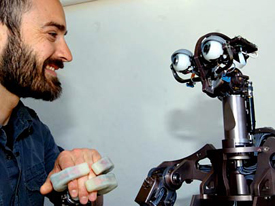Dr. Aaron Edsinger
The MIT News article Assistive robot adapts to people, new places said
“In the futuristic cartoon series ‘The Jetsons’, a robotic maid named Rosie whizzed around the Jetsons’ home doing household chores — cleaning, cooking dinner and washing dishes.Such a vision of robotic housekeeping is likely decades away from becoming reality. But at MIT, researchers are working on a very early version of such intelligent, robotic helpers — a humanoid called Domo who grasp objects and place them on shelves or counters.
A robot like Domo could help elderly or wheelchair-bound people with simple household tasks like putting away dishes. Other potential applications include agriculture, space travel and assisting workers on an assembly line, says Aaron Edsinger, an MIT postdoctoral associate who has been working on Domo for the last three years.
Edsinger describes Domo as the ‘next generation’ of earlier robots built at MIT — Kismet, which was designed to interact with humans, and Cog, which could learn to manipulate unknown objects. Domo incorporates elements of both of those robots.”
Aaron Edsinger, Ph.D. is cofounder of the robotics companies HeeHeeHee Labs and Meka Robotics. He is also a post-doctoral researcher at the MIT Computer Science and Artificial Intelligence Laboratory. He is working in the Humanoid Robotics Group led by Professor Rodney Brooks. His research interests are in developmental and behavior based cognitive architectures for humanoid robots, bimanual robot manipulation, compliant manipulator and hand design, and sensorimotor learning for manipulation.
Aaron is author of Robot Manipulation in Human Environments and A Gestural Language For A Humanoid Robot, and coauthor of Sensing and Manipulating Built-for-Human Environments, Active Vision for Sociable Robots, Social Constraints on Animate Vision, Human-Robot Interaction for Cooperative Manipulation: Handing Objects to One Another, Two Arms are Better than One: Designing Robots that Assist People in Everyday Manual Tasks, Manipulation in Human Environments (winner of the Best paper award at the IEEE-RAS International Conference on Humanoid Robots), and What Can I Control?: The Development of Visual Categories for a Robot’s Body and the World that it Influences. Read the full list of his publications!
Aaron earned his Bachelor of Science in Computer Systems Engineering from Stanford University in 1994, his Master of Science in Computer Science from the Massachusetts Institute of Technology in 2000, and his Doctor of Philosophy in Computer Science from the Massachusetts Institute of Technology in 2007.
Watch The Robot’s Grasp and The Uncanny Valley. Read New Robot Eyes People With Human-Like Eyes.
